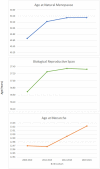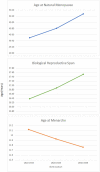Women's reproductive span: a systematic scoping review
- PMID: 35280216
- PMCID: PMC8907405
- DOI: 10.1093/hropen/hoac005
Women's reproductive span: a systematic scoping review
Abstract
Study question: What is the scope of literature regarding women's reproductive span in terms of definitions, trends and determinants?
Summary answer: The scoping review found a wide variation in definitions, trends and determinants of biological, social and effective women's reproductive span.
What is known already: A woman's reproductive span refers to her childbearing years. Its span influences a woman's reproductive decisions.
Study design size duration: A systematic scoping review was conducted. We searched MEDLINE, PubMed, JSTOR, CINAHL, Web of Science and Scopus electronic databases from inception to January 2021 without imposing language or date restrictions. We searched unpublished sources including the Global Burden of Disease, Demographic and Health Surveys, and National Health and Nutrition Examination Surveys. The list of relevant references was searched by hand. Sixty-seven reports on women's reproductive span were included in this review.
Participants/materials setting methods: This scoping systematic review followed an established framework. The reporting of this scoping review followed the reporting requirements provided in the Preferred Reporting Items for Systematic Reviews and Meta-Analyses, Extension for Scoping Reviews. Identified records were independently screened and data were extracted. We performed conceptual synthesis by grouping the studies by available concepts of reproductive span and then summarized definitions, measures used, temporal trends, determinants, and broad findings of implications on population demographics and assisted reproduction. Structured tabulation and graphical synthesis were used to show patterns in the data and convey detailed information efficiently, along with a narrative commentary.
Main results and the role of chance: A total of 67 relevant reports on women's reproductive span were published between 1980 and 2020 from 74 countries. Most reports (42/67) were cross-sectional in design. Literature on reproductive span was conceptually grouped as biological (the interval between age at menarche and age at menopause), effective (when a woman is both fertile and engaging in sexual activity) and social (period of exposure to sexual activity). We summarized the working definitions, trends and determinants of each concept. Few articles addressed implications on demographics and assisted reproduction.
Limitations reasons for caution: A formal assessment of methodological quality of the included studies was not performed because the aim of this review was to provide an overview of the existing evidence base regardless of quality.
Wider implications of the findings: The review produced a comprehensive set of possible definitions of women's reproductive span, trends, and potential determinants. Further advancement of these findings will involve collaboration with relevant stakeholders to rate the importance of each definition in relation to demography and fertility care, outline a set of core definitions, identify implications for policy, practice or research and define future research opportunities to explore linkages between reproductive spans, their determinants, and the need for assisted reproduction.
Study funding/competing interests: This work received funding from the UNDP-UNFPA-UNICEF-WHO-World Bank Special Programme of Research, Development and Research Training in Human Reproduction (HRP), a cosponsored programme executed by the World Health Organization (WHO). The authors had no competing interests.
Study registration number: N/A.
Keywords: assisted reproduction; demography; female; humans; infertility; menarche; menopause; reproductive span.
© The Author(s) 2022. Published by Oxford University Press on behalf of European Society of Human Reproduction and Embryology.
Figures






References
-
- Arksey H, O’Malley L. Scoping studies: towards a methodological framework. Int J Soc Res Methodol 2005;8:19–32.
-
- Aydos SE, Elhan AH, Tükün A. Is telomere length one of the determinants of reproductive life span? Arch Gynecol Obstet 2005;272:113–116. - PubMed
-
- Barlow DH. Interventions in the prolongation of reproductive life in women. The prolongation of reproductive life in women. Ann N Y Acad Sci 2011;1221:1–9. - PubMed
-
- Beall CM. Ages at menopause and menarche in a high-altitude Himalayan population. Ann Hum Biol 1983;10:365–370. - PubMed
Publication types
Grants and funding
LinkOut - more resources
Full Text Sources
Medical
Research Materials
